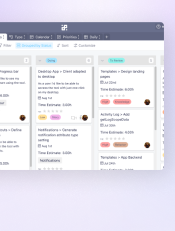What Are Product Manager's Roles and Responsibilities
A product manager is responsible for setting a strategic plan for product creation and making sure that the plan is executed. In other words, a product manager is in charge of the following:
- Conducting market research, competitor analysis, and customer research
- Setting a product vision and strategy that states the unique value of the product
- Creating a product roadmap with a clearly defined action plan, defining the responsibilities and the timeline
- Coordinating among design, engineering, and marketing teams
- Owning the Daily Scrum and Sprint Planning meetings, ensuring that all developers understand the user stories and are clear on what needs to be built
- Defining and analyzing product metrics and analytics
Put even more simply, as a product manager, you will have three main responsibilities:
- Set the strategy and long-term vision
- Share this strategy with all the stakeholders
- Oversee the execution of the strategy

Transparency Is Key
A great product manager should be the go-to person for all questions related to the product and the linking element of the whole team. That’s why they need to be as transparent as possible in the prioritizing process.
Although the product manager will have the final say, it’s important to keep all stakeholders in the loop when it comes to making decisions.
Having all the data necessary in one place - or one tool - will make it much easier for product managers to explain why they are prioritizing certain features over others and why they sometimes have to say no.
What Software Should a Product Manager Use?
To be productive in the role of a product manager, you should find the right tools that will make your job easier. Nowadays, there are many product management tools that help you develop your whole product strategy and keep all information in one place.
Here are some product management software features that come in handy:
- User tracking/analysis — One of the best ways to get insight into your users’ behavior and the way they react to your product. This way, you can continually improve the product to better fit user needs.
- Customer survey tools — Direct customer feedback is invaluable, as you can learn all about the things your users love or hate about a product. Some product management software lets you create survey templates and easily send survey forms to your users.
- Prototyping — Get your product on the right track from the first step. Create a prototype you can easily share with the stakeholders.
- Roadmapping — A roadmapping tool helps you define features and plan releases, track development status and progress, plan and allocate development resources, and collaborate with your product team.
- Task management — Assign tasks to team members and follow task progress in real time, define and prioritize tasks, and streamline your whole task management process.
- Data management/sharing — A quality product management tool makes it simple to upload and share documents and data with your team members.
- Instant messaging — Be able to quickly contact anyone on the team and get the information you need as soon as possible.
To learn more about the right tools to use, you can read our review of the 20 best product management software for everything from small businesses to enterprises.
Introduction To Product Management
Product Strategy


Product Management

Lifetime Discount Is Waiting
Enjoy 50% off the Unlimited White Label plan. All features, unlimited users, and full white label access — one fixed price for life.
Get the Special Offer






